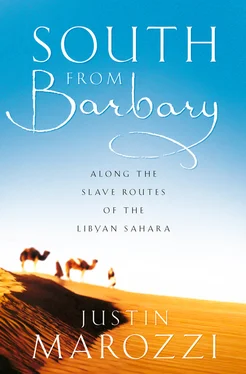In the twelfth century, Venetians were bringing arms, textiles, glassware and exotic products like Arabian spices, Indian gems and Chinese silks to Tripoli, carried off by local merchants into the desert. By Leo Africanus’s time, four centuries later, European cloth was still a staple of the Saharan caravan trade. Together with clothes, brass vessels, horses and books, it was exchanged for gold, slaves and zebed (civet). This olfactory delight was procured from civet cats, which were kept in cages and periodically harangued and taunted until through intense perspiration they secreted a perfume from glands beneath the tail. They were then secured, the goo was scraped from their nether regions, preserved in small boxes of hide and sold at great expense as a scent-fixer for perfumes (did Victorian women know what they were dabbing onto their necks?). ‘A savage old cat will produce ten or twelve dollars’ worth in three heats,’ noted Lyon in 1819 (at the ripe age of twenty-two and without consulting anyone he had promoted himself from lieutenant to ensure a more respectful reception from the natives). ‘Their price is enormous, some being sold for three or four slaves.’
Lyon provided one of the most comprehensive accounts of the goods traded along Libya’s second trade route running south from Tripoli to Murzuk, Bilma and Kukawa, west of Lake Chad. It gives an idea of what the caravans were trading with Ghadames at the same time. From the coast came horses, beads, coral, needles (‘four of which purchase a fine fowl’), silks, copper pots and kettles, looking-glasses, swords (‘very long, straight and double edged; bought greedily by the Tuarick’), guns, carpets from Tripoli, Venetian glass, muslins and woollen cloaks. Among goods brought up from the south, slaves still predominated, accompanied by civet, cottons, gold in dust and small bars or rings, leather, ostrich skins and feathers, ornamental sandals, gerba s (water skins made of goats’ hides), honey, pepper, elephants’ teeth and gooroo nuts, a luxury that went at the rate of four to the Spanish dollar. ‘It is said, that in certain years when the nut has been scarce, people in Soudan have given a slave for one of them,’ the indefatigable Lyon reported. Ghadamsi merchants meanwhile brought swords, guns, powder, flints, lead, ironware and clothing to Murzuk for the annual spring market.
By the time Richardson arrived, Ghadames had passed its apogee. Turkish rule, with its capricious system of extortion, was hurting. During the Karamanli dynasty, the city had paid an annual tribute of 850 mahboubs to Tripoli. Richardson learnt that when the Turks took control of the city after their reconquest of Tripoli in 1835, they had demanded a forced contribution of 50,000 mahboubs, stripped women of their gold and silver, ransacked houses, and instituted an annual tribute of 10,000 mahboubs from the city. To make matters worse, Tripoli had just demanded an extraordinary levy of 3,200 mahboubs, which the beleaguered merchants said they were unable to pay. Richardson, who was soon on friendly terms with the Turkish governor, listened to him explaining the essence of Ottoman colonial policy in the territory. ‘You know Arabs to be very devils,’ he told the Englishman.
There are two ways to consider Arabs, but whichever way they are robbers and assassins. When they are famished, they plunder in order to eat; when their bellies are full, they plunder because they kick and are insolent. Now we (Turks) keep them upon a low diet in The Mountains; they have little, and always a little food. This is the Sultan’s tareek (government) to manage them. Their spirits are kept down and they are submissive.
Having mulled over his own ambitions as an explorer, Richardson now rediscovered his ‘humane mission on the behalf of unhappy weak Africans, doomed by men calling themselves Christians, to the curse of slavery’, and set about his investigation of the trade. It did not take him long to realize the scale of the challenge facing the abolitionists: ‘Slave-dealing is so completely engendered in the minds of the Ghadamsee merchants, that they cannot conceive how it can be wrong. They are greatly astonished that slavery is not permitted among us.’
One day, he watched a caravan of forty slaves arrive from Bornu. ‘They were as much like merchandize as they could be, or human beings could be made to resemble it,’ he recorded. ‘They were entirely naked, with the exception of a strip of tanned skin tied round the loins. All were nearly alike, as so many goods packed up of the same quality. They were very thin, and almost skeletons, about the age of from ten to fifteen years, with the round Bornouse features strongly marked upon their countenances.’ As the Turks had taxed Ghadamsis with such ferocity, there were few merchants in the town who could afford to purchase the slaves, and Richardson had to fend off repeated attempts by the Touareg and Tubbu slave owners to get him to buy these hapless creatures himself. The merchants had hoped to sell them for forty to fifty Spanish dollars a head, but were reduced to disposing of them for twenty, of which half went to the government in duty.
Later, he encountered another slave caravan and was deeply moved by the misery of these
poor little children – child-slaves – crawling over the ground, scarcely able to move. Oh, what a curse is slavery! How full of hard-heartedness and cruelty! As soon as the poor slaves arrived, they set to work and made a fire. Some of them were laden with wood when they came up. The fire was their only protection from the cold, the raw bitter cold of the night, for they were nearly naked. I require as much as three ordinary greatcoats, besides the usual clothing of the day, to keep me warm in the night; these poor things, the chilly children of the tropics, have only a rag to cover them, and a bit of fire to warm them. I shall never forget the sparkling eyes of delight of one of the poor little boys, as he sat down and looked into the crackling glaring fire of desert scrub.
Since the slave drivers were paid per capita to deliver their charges to their destination, they saved expenses by giving them as little food as possible. As a result, they were kept on survival rations consisting of barley meal mixed with water. Richardson’s attendant, he noted, ate more for dinner than a slave’s entire daily ration. By the time they got to their destination, they would be no more than ‘living-skeletons’.
Richardson stayed in Ghadames for three months, spending much of his time dispensing medicine to treat the most common illnesses – ophthalmia (inflammation of the eye), diarrhoea, dropsy, smallpox and syphilis – telling his unsuspecting patients it came from the Queen of England, ‘which, I have observed, heightens its value in their eyes’. He was something of a chameleon, at one moment the impassioned liberal, the next a Christian bigot, sometimes a patriotic British imperialist, at others the vitriolic anti-slave trade campaigner. But whatever his mood, he was a consistently – perhaps unintentionally – entertaining observer of his surroundings. The discovery that some men wore kohl to blacken their eyelids, for instance, completely threw him. ‘I confessed I was surprised at this monstrous effeminacy,’ he fumed.
More importantly, his investigations led him to conclude that two merchants under British protection were providing credit to slave-traders. He promptly wrote a letter to that effect to Colonel Warrington in Tripoli, asking him not to publicize this information until he himself was safely out of the desert, for fear of reprisals. The correspondence must have made Warrington squirm:
We may expect one of these days to see some American President coming forward in the Congress of the United States, as the late Mr Slaveholder Tigler, or some French Deputy in the Chamber with a statement to the following effect: ‘that whilst the British Consuls of Barbary, and the agents of the British and Foreign Anti-Slavery Society are labouring for the suppression of the Slave Trade in Northern and Central Africa, the traffic in Slaves between Soudan and Tripoli is principally carried on by the means of British capital’.
Читать дальше


![Theresa Cheung - The Dream Dictionary from A to Z [Revised edition] - The Ultimate A–Z to Interpret the Secrets of Your Dreams](/books/692092/theresa-cheung-the-dream-dictionary-from-a-to-z-r-thumb.webp)









